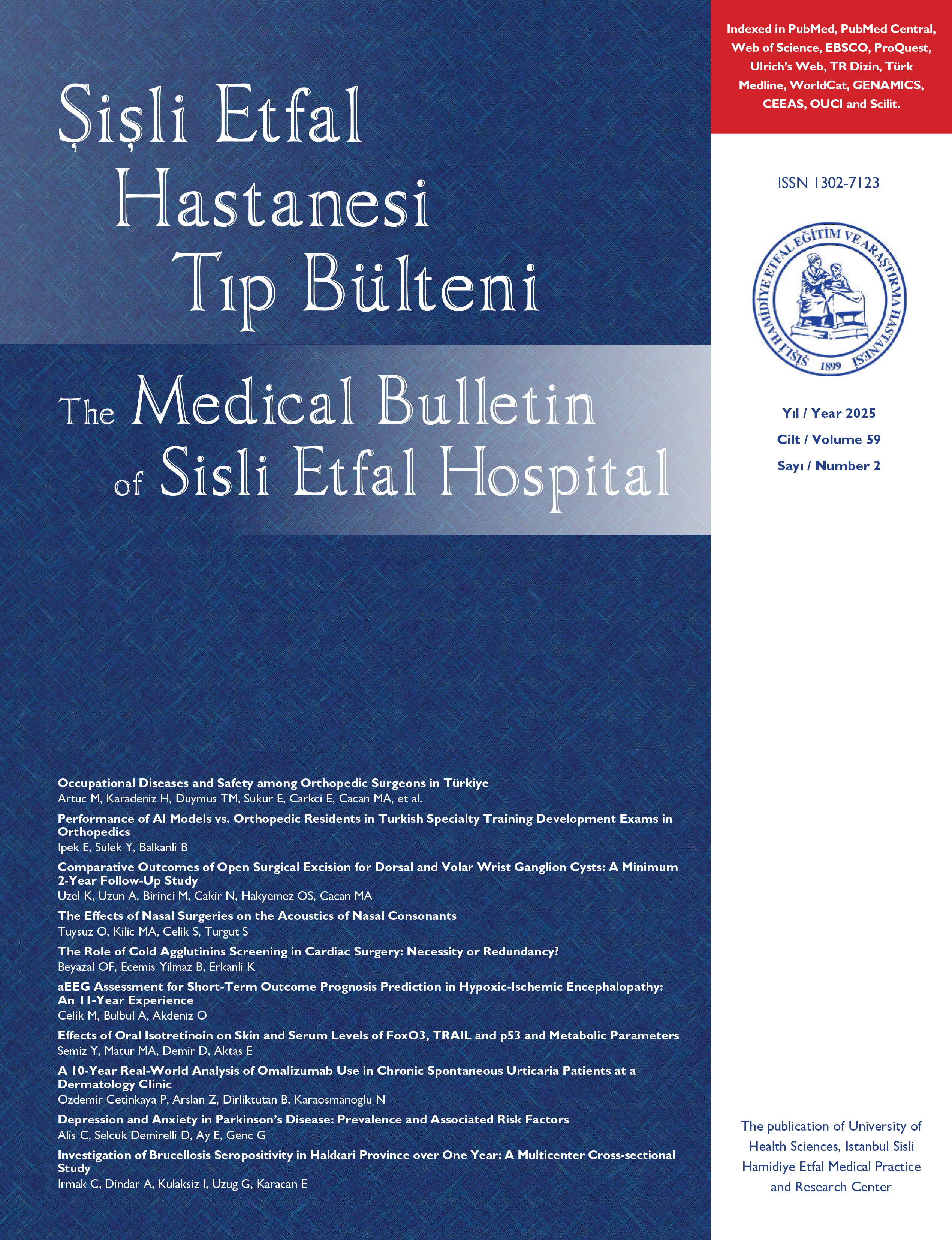
Sefalosporin Allerji Öyküsü Olan Çocuklarda Penisilin ve Sefalosporinler Arasındaki Çapraz Reaksiyonun Değerlendirilmesi
Nursah Eker1, Gunsel Kutluk2, Feyzullah Cetinkaya31Marmara Üniversitesi Tıp Fakültesi, Çocuk Sağlığı ve Hastalıkları Anabilim Dalı, İstanbul2Türkiye Sağlık Bilimleri Üniversitesi, Başakşehir Cam ve Şakura Şehir Hastanesi, Çocuk Sağlığı ve Hastalıkları Kliniği, İstanbul
3Acıbadem International Hastanesi, Çocuk Sağlığı ve Hastalıkları Kliniği, İstanbul
Amaç: Sefalosporinler ve penisilinler arasındaki çapraz reaksiyon daha çok penisilin alerji öyküsü olan hastalarda değerlendirilmiştir. Ancak sorunun diğer yönüne, yani öncelikle sefalosporinlere karşı duyarlılığı olan deneklerdeki çapraz reaksiyona ilişkin çok az veri mevcuttur. Bu prospektif çalışma ile, sefalosporinlere karşı alerjik reaksiyon öyküsü olan hastalarda penisilinlere ve diğer bazı sefalosporinlere karşı çapraz reaksiyonu değerlendirmek amaçlanmıştır.
Yöntem: Çalışmaya en az bir sefalosporine karşı alerjik reaksiyon öyküsü olan 21 çocuk dahil edildi. Deri testi, penisilinler ve yaygın olarak kullanılan üç sefalosporinin (sefazolin, sefuroksim ve seftriakson) minör ve majör determinan karışımlarından oluşan bir panel ile gerçekleştirildi.
Bulgular: Çocuklar önceki yılda herhangi bir beta-laktam antibiyotiğin 5,14 ± 4,91 (1-15) katı kullanmış ve en sık suçlanan sefalosporinler seftriakson (%42,92) ve sefuroksim, sefazolin, sefiksim, sefprozil ve sefotaksim (%9,5 her biri için) olmuştur. On dört (%66,7) olguda herhangi bir sefalosporin ile, 15 (%71,4) olguda ise penisilin alerjenleri ile deri testleri pozitif saptandı. Toplamda sefalosporin allerjisi pozitif olan çocukların %85,7'sinin penisiline veya üç sefalosporinden herhangi birine duyarlı olduğu belirlendi.
Sonuç: Sefalosporinlere karşı tip I aşırı duyarlılık reaksiyonu öyküsü olan çocuklarda penisilin ve diğer sefalosporinlere karşı advers reaksiyon gelişme riski yüksek görünmektedir. Bu nedenle sefalosporin allerjisi öyküsü olan hastalarda, kullanılmadan önce hem sefalosporinler hem de penisilinlerle deri testi yapılmalıdır. (SETB-2023-12-220)
Anahtar Kelimeler: Beta-laktmalar, sefalosporinler, penisilinler
Evaluation of Cross-Reactivity Between Penicillins and Cephalosporins in Children with a History of Cephalosporin Allergy
Nursah Eker1, Gunsel Kutluk2, Feyzullah Cetinkaya31Department of Pediatrics, Marmara University Faculty of Medicine, Istanbul, Türkiye2Department of Pediatrics, University of Health Sciences Türkiye, Basaksehir Cam ve Sakura City Hospital, Istanbul, Türkiye
3Department of Pediatrics, Acibadem International Hospital, Istanbul, Türkiye
bjectives: The cross-reactivity problem between cephalosporins and penicillins has mainly been evaluated in the context of patients allergic to penicillins. However, we have little data regarding the opposite aspect of the problem, i.e. the cross-reactivity in subjects primarily sensitized to cephalosporins. This prospective study aims to evaluate the cross-reactivity to penicillins and some other cephalosporins in patients with immediate allergic reactions to cephalosporins.
Methods: The study included 21 children with immediate allergic reactions to at least one cephalosporin. Skin testing was performed with a panel of minor and major determinant mixtures of penicillins and three commonly used cephalosporins (cephazoline, cefuroxime and ceftriaxone).
Results: The children had used 5.14±4.91 (1-15) times any beta-lactam antibiotic in the previous year and the most common cephalosporins accused were ceftriaxone (42.92%), and cefuroxime, cefazolin, cefixime, cefprozil and cefotaxime (9.5% each). Skin tests were positive for any cephalosporin in 14 (66.7%) subjects and penicillin allergens in 15 (71.4%) subjects. Totally, 85.7% of children with a positive allergy history to cephalosporins were found to be sensitive to either penicillin or any one of three cephalosporins. Conclusion: There seems to be a high risk of adverse reactions to penicillins and other cephalosporins in children with a history of type I hypersensitivity reaction to cephalosporins. Therefore, skin testing with both cephalosporins and penicillins should be performed in patients with a history of cephalosporin allergy.
Keywords: Beta-lactams, cephalosporins, penicillins
Makale Dili: İngilizce



















